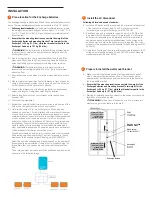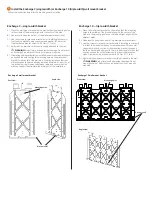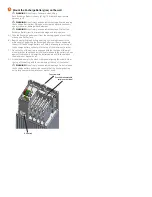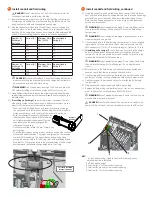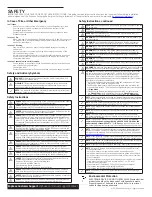
INSTALLATION
Plan a location for the Encharge batteries
The Encharge housing is NEMA type 3R and can be installed indoors or out-
doors. The terminal blocks accepts copper conductors of No. 12 - 8 AWG.
A )
Following local standards,
choose a well-ventilated location where
the ambient temperature and humidity are within -15° C to 55° C (-5°
F to 131° F) and 5% to 100% RH, non-condensing, preferably out of
direct sunlight.
B )
Ensure that the mounting location can sustain the weight of the
Encharge batteries and mounting bracket. Total weight for the
Encharge 3 is 53 kg (117 lbs), while the three battery units in the
Encharge 10 add up to 157 kg (346 lbs).
*
WARNING:
The installer should install blocking between studs
to ensure that no single stud carries the entire weight load of the
Encharge batteries.
C ) Plan the mounting location to be at least 30cm (one foot) off the
ground and 30cm (one foot) from the ceiling. Keep the Encharge
away from falling or moving objects, including motor vehicles.
*
WARNING:
If mounted in the path of a motor vehicle, we
recommend a mounting height that is 91 cm (36-inch) minimum
above the floor.
D ) Ensure that there are no pipes or electrical wires where you plan to
drill.
E ) Plan to maintain at least three feet of clearance in front of each En-
charge. Allow enough clearance on top and sides of the Encharge
so that the vents on the cover are not blocked.
F ) Consider the dimensions of the Encharge batteries, easy access,
height, and length of cable when selecting the location.
G ) Select a location where you can interconnect to the Enphase
Enpower MID.
H ) Follow all local standards.
J ) Review your external conduit plan to determine to which side of the
field wiring compartment you will connect conduit.
K ) Up to two Encharge 10 (or six Encharge 3) units can be daisy
chained on one circuit. For installations with more than this number
of units, there must be a separate load center, subpanel, or circuit
combiner with over current protection to combine the daisy chained
circuits, and you must run only one circuit for all the Encharge
units to the Enpower (or to Enphase AC Combiner for grid-tied-only
installations). You must select proper conductors and AC discon-
nects for these circuits according to local codes, standards, and
other applicable requirements. Enpower supports up to a maximum
of 80 A breaker for Encharge connection circuit.
The subpanel could be a small, two circuit box with circuit breakers
(the drawing only shows switches). The circuit breakers in the box
would have to be suitable for back-feeding, per NEC 408.36(D).
Select the right size subpanel and breakers based on the number of
Encharge units being installed. If there are only three Encharge 10s,
for example, then you can use a box with current rating less than
80A.
To do this, you must purchase an off-the-shelf subpanel and install
as shown in the following image:
1
Install the AC disconnect
Following all local codes and standards:
A ) Install an AC disconnect that can break the maximum rated current
of the branch circuit under load. The AC disconnect must be
installed in line-of-sight of Encharge, per NEC 706.7(A).
B ) Each Encharge unit is suitable for use with up to No. 8 AWG wires
on a maximum 40 A branch circuit. If more than 32 A of Encharge
batteries (corresponding to a 40 A branch circuit) are installed, a
separate subpanel must be installed between the Encharge units
and Enpower to combine the Enpower circuits together. All circuit
breakers in the subpanel must be suitable for back-feeding, per NEC
408.36(D).
C ) Verify that AC voltage at the site is within range: single-phase L1 to L2
voltage must measure between 211 and 264 VAC, while L-N should
measure between 106 and 132 VAC.
2
Prepare to install the wall-mount bracket
A ) Make sure that the planned position for the wall-mount bracket
meets clearance requirements as shown. The image depicts a
single bracket, but clearances and requirements are the same for
the triple-width bracket.
B )
Ensure that the mounting location can sustain the weight of the
Encharge batteries and mounting bracket. Total weight for the
Encharge 3 is 53 kg (117 lbs), while the three battery units in the
Encharge 10 add up to 157 kg (346 lbs).
C ) Starting at installation position closest to the power source, mark a
level line on the wall as a guide.
*
WARNING!
Multiple risks. Make sure not to drill or attach into
electric wiring or pipes that are in the wall!
3
Minimum 30cm
(one foot) from
ground/next
surface below
Minimum 30cm
(one foot) from
ceiling/next
surface above
Blocking installed
between studs
Wood screw
7.6 cm (#10x3”)
Encharge Battery



